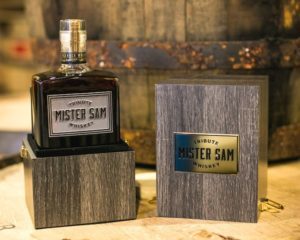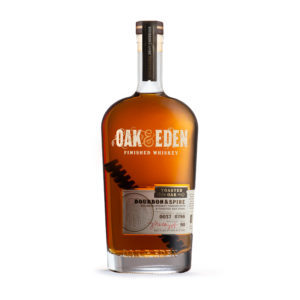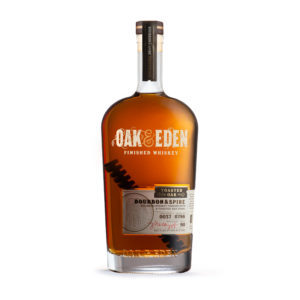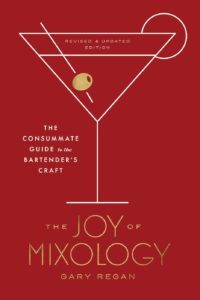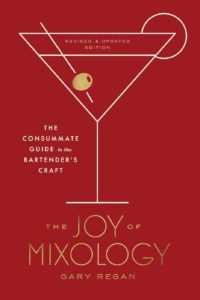Arthur Shapiro's Blog, page 3
August 23, 2019
Tony Sachs: Outstanding Spirits Writer and All-Around Mensch
I have become totally fascinated by, and admire, the spirits writers who have come to play an important role in the booze business. When I started in the industry, and for much of the 1990s, there were not as many as there are today and I believe the spirits industry is better for their presence.
I enjoy reading and aspiring to write as well as people like Noah Rothbaum, Fred Minnick, Lew Bryson, Rosie Schaap, Dave Wondrich, Amanda Schuster, and others. With their willingness, I hope to write about them as I have in the past with Paul Pacult and Gaz Regan. So, consider this the first in a series about people who influence the business from behind their computer.
 Photo by Gabi Porter
Photo by Gabi PorterTony’s Story
Simply put, I love reading what he writes and, for me, he was a top choice to focus on. I can tell you why in a long-winded manner, but I thought why not ask a mutual friend in the industry about Tony, someone who knows him personally and professionally. I turned to Joe Magliocco, President Chatham Imports, Inc. who said this:
“Tony Sachs is a terrific spirits writer. He asks thoughtful and insightful questions, and writes with a very engaging style. His articles are always interesting. He has an encyclopedic knowledge of spirits, especially whiskeys, and an extremely sophisticated palate.”
Beyond his writing, Tony is very down to earth, an affable and fun guy to hang out with and have a few. I follow him on Facebook and love his posts about him and his family and especially the exotic trips and dinners with spirits suppliers. (Often as I read about these journeys, I’m reminded of the adage from back in the day — “You won’t become a millionaire working at Seagram but you’ll sure live like one.”)
Tony is a lifelong New Yorker with the gift of writing in his DNA. Both his parents were, as he puts it, Mad Men era type copywriters and he has a BA in journalism from NYU. Despite this, Tony had always been obsessed with music and, foregoing law school, opened a record shop in the Upper Westside of NYC. The store had a pretty good run of 12 years from 1993 to 2005. A business can flourish but if the environment for that business changes, it faces an uphill battle.
As the music business was traveling south around 2005, Tony set his sights on another passion he had, one which was growing at the time — the return of the cocktail culture.
He first became interested in the history of cocktails while running his store and read William Grimes‘ “Straight Up Or On The Rocks: The Story Of The American Cocktail.”
As he explained it to me:
“A customer of mine dealt in rare books, and I built up a nice collection of vintage bar/cocktail books from him, long before most folks knew or cared about them. I also got to know about whiskey because one of the friends of the store worked at Union Square Wine and Spirits. He’d bring my partner terrific bottles, like Sazerac 18 YO or Rittenhouse 21, and my partner actually didn’t like them! So, he’d either give them to me or I’d trade him other stuff from my collection. It was a great education! Anyway, by 2005 I knew more about booze than your average consumer, even if I was still at beginner-level standards compared to titans like Gaz Regan or David Wondrich.”
Writing About Spirits
So, Tony knew about writing, knew about booze, but didn’t know about booze writing. The seminal moment came when he took a wine and spirits course from the legendary Harriet Lembeck. As he put it, “I found the wine part pretty uninteresting, but the spirits part really grabbed me.”
What followed was an immersion in the NYC burgeoning cocktail scene, getting to meet people like Gaz Regan, Jill and Dale DeGroff, and others, and some “toe in the water” articles for Huffington Post. An article on vermouth. Then an article on bourbon. Next thing he knew, PR folks were inviting him to tastings and he got a writing gig for The Liquid Muse. The rest is history.
 His wall of booze
His wall of boozeHis articles
Tony’s articles have appeared in the Robb Report, Esquire, Serious Eats, Liquor.com, Whiskey Advocate, Whiskey Wash, among others. Here are some that you might enjoy reading.
“Do the TTB’s Proposed New Regulations Leave Craft Distillers Over a Barrel?” This is a very recent article in Whiskey Advocate on an important subject for craft producers.
“New York In The ‘90s, Drunkenly.” A fun and interesting nostalgic read about the concoctions that passed for cocktails. Written for medium.com.
And, of course, a fun article that you would expect from a spirit’s writer who loves music — “Ten Classic Drinking Songs Recorded by Women,” which appeared in Thirsty.
Putting him to the test
In addition to the fun topics above, Tony is widely known for his spot-on product reviews. So, while we were talking about his career, I invited him over to taste the Mister Sam Whiskey I recently received. I had saved opening it for just this occasion. (See my reference to the brand earlier this summer.)
It was fun watching him work and he saw something I had missed — the AbV is 66.9%. His review is in Whisk(e)y of the Week, which appeared recently in Liquor.com. Here is an excerpt:
Sazerac’s master blender, Drew Mayville, has his artistry on full display here. Dark fruit, most noticeably plums and cherries, mingle with brown sugar, gingerbread and baking spices, along with a fair amount of oak and rye spice. The finish is long and a little hot without water, but much more palatable than the high ABV would lead you to believe. A few drops of water turn down the heat and turns up the fruity and oaky notes without diluting the flavor in the least.
Actually, truth be told, his review depressed me a bit … There is no way I could write a review like that. All I tasted and smelled was whiskey. I guess I’ll just stick to stories.
Oh, and by the way, here’s part of the blurb about Tony that accompanied the story in Liquor.com:
Stay-at-home dad, 20th century music enthusiast, eater of dumplings. Opinionated but generally pleasant about it.
I told you he was a mensch.
The post Tony Sachs: Outstanding Spirits Writer and All-Around Mensch first appeared on Booze Business: A Blog Dedicated to the Business of Spirits and Wine.
July 29, 2019
Is there anything gaz regan wouldn’t do to get attention?
Gaz and I have known each other and been friends since the 1990s. More recently, we have become business associates in matters pertaining to the role of bartenders in brand building and business development. Together we launched Worldwide Bartender Database
We speak often and a short while ago he told me that during the course of a medical exam, the doctors found a spot on his lung that needed to be removed.
I freaked out. But he was particularly and unusually calm about the matter.
Got me to thinking… was this real? Was he pulling my leg? Or was he up to his old, attention getting tricks.
Now, before you think me cold and heartless, let’s examine Mr. Regan’s shenanigans:
In 2001 he started Cocktails in the Country, a bartending course believed to be the only bartending program in NY that used real spirits, as opposed to colored water.
By 2007 Jim Meehan, Dave Kaplan, Don Lee, H. Joseph Ehrmann, Jacques Bezuidenhout, Jamie Boudreau, Jared Brown, Anistatia Miller, Joaquin Simo, Jonathan Pogash, Naren Young, Philip Ward, Robert Hess, Sammy Ross, Toby Cecchini, Toby Maloney, and Willy Shine, among many others had all taken the CitC course.
In 2008 he started wearing eye-liner. (That’s right… among other reasons, he claimed it helped him make the point with bartenders that eye-contact with customers across the bar was an important element of ‘mindful bartending.’)
In 2009 he changed his name so he, like Prince, could be known as “The Bartender Formally Known as . . .”
In 2010 he started the Finger-Stirred Negroni Craze, which captured the world’s attention. Not long after, he had his finger cast in stainless steel and made into a stirrer.
And now, in order to create a buzz, gaz didn’t go to Tales of the Cocktail this year. Choosing instead to have half of his left lung ripped out.
So, you’ll forgive me if I was a tad skeptical.
“Well, in all truth” says gaz, “I didn’t have much of a choice in this one cos, according to my doctors I had a tiny pea-size lump of very aggressive cancer in there, but I couldn’t help but make a big deal of it, cos I’m known for never missing a chance to shock the world.”
Truth of the matter is that, after his operation, tests were performed, and gaz has been declared to be totally cancer free, and he’ll be out on the road again after he spends a couple of weeks being spoiled rotten by Amy his wife.
“I have to get back out there to make the money I missed out on by pulling this particular stunt,” says gaz, “So, if you doubt, for a second, that a two-time cancer survivor with hardly a tooth in his head, only half of a tongue and half of one of his lungs is up to the task, get in touch with me at The Worldwide Bartender Database and I’ll show you how it’s done.”
In truth folks, gaz has been laid up and concerned but now that he’s in the clear, this blog post was his inspiration. It’s his way of… well… back to being gaz regan.
All I can say is: Twasn’t my fault, Mum… He put me up to it.
So, forgive us if we had a bit of fun at f**ken cancer’s expense.
Is there anything gaz regan wouldn’t do to get attention?
Gaz and I have known each other and been friends since the 1990s. More recently, we have become business associates in matters pertaining to the role of bartenders in brand building and business development. Together we launched Worldwide Bartender Database
We speak often and a short while ago he told me that during the course of a medical exam, the doctors found a spot on his lung that needed to be removed.
I freaked out. But he was particularly and unusually calm about the matter.
Got me to thinking… was this real? Was he pulling my leg? Or was he up to his old, attention getting tricks.
Now, before you think me cold and heartless, let’s examine Mr. Regan’s shenanigans:
In 2001 he started Cocktails in the Country, a bartending course believed to be the only bartending program in NY that used real spirits, as opposed to colored water.
By 2007 Jim Meehan, Dave Kaplan, Don Lee, H. Joseph Ehrmann, Jacques Bezuidenhout, Jamie Boudreau, Jared Brown, Anistatia Miller, Joaquin Simo, Jonathan Pogash, Naren Young, Philip Ward, Robert Hess, Sammy Ross, Toby Cecchini, Toby Maloney, and Willy Shine, among many others had all taken the CitC course.
In 2008 he started wearing eye-liner. (That’s right… among other reasons, he claimed it helped him make the point with bartenders that eye-contact with customers across the bar was an important element of ‘mindful bartending.’)
In 2009 he changed his name so he, like Prince, could be known as “The Bartender Formally Known as . . .”
In 2010 he started the Finger-Stirred Negroni Craze, which captured the world’s attention. Not long after, he had his finger cast in stainless steel and made into a stirrer.
And now, in order to create a buzz, gaz didn’t go to Tales of the Cocktail this year. Choosing instead to have half of his left lung ripped out.
So, you’ll forgive me if I was a tad skeptical.
“Well, in all truth” says gaz, “I didn’t have much of a choice in this one cos, according to my doctors I had a tiny pea-size lump of very aggressive cancer in there, but I couldn’t help but make a big deal of it, cos I’m known for never missing a chance to shock the world.”
Truth of the matter is that, after his operation, tests were performed, and gaz has been declared to be totally cancer free, and he’ll be out on the road again after he spends a couple of weeks being spoiled rotten by Amy his wife.
“I have to get back out there to make the money I missed out on by pulling this particular stunt,” says gaz, “So, if you doubt, for a second, that a two-time cancer survivor with hardly a tooth in his head, only half of a tongue and half of one of his lungs is up to the task, get in touch with me at The Worldwide Bartender Database and I’ll show you how it’s done.”
In truth folks, gaz has been laid up and concerned but now that he’s in the clear, this blog post was his inspiration. It’s his way of… well… back to being gaz regan.
All I can say is: Twasn’t my fault, Mum… He put me up to it.
So, forgive us if we had a bit of fun at f**ken cancer’s expense.
The post Is there anything gaz regan wouldn’t do to get attention? first appeared on Booze Business: A Blog Dedicated to the Business of Spirits and Wine.
July 17, 2019
“Hey, there’s wood in my bottle.”
Who can argue that wood plays a vital role in the taste of your favorite whisk(e)y. In fact, in a Vinepair article it’s estimated that “wood is responsible for 60 to 75 percent of the taste of a finished whiskey.”
More than that, wood is the star of whiskey making with various types of oak, casks that previously held other spirits (even wine), different toasting techniques, even double barrel resting. Maker’s Mark 46 goes one step further and adds wood staves to the barrels. Described as follows: “The innovative wood-stave-finishing process starts with fully matured Maker’s Mark at cask strength. We then insert 10 seared virgin French oak staves into the barrel and finish it for nine weeks in our limestone cellar.”
A new and unique approach
The Sanctified Spirits Company, a startup in Texas, which owns the Oak & Eden brand of bourbon and rye whiskeys, uses a spiral piece of wood (referred to as a spire) inserted into the bottle. This patent pending technique, which they call in-bottle finished whiskey, consists of a 5-inch spiral cut piece of wood from the same species of wood as the barrel. They rest the product for 6 weeks and sell the whiskey with the spire in it.
While I am not a whiskey taster/reviewer, I’m an avid American Whiskey fan, so I tried it to see what it tastes like. The one I tried was Bourbon & Spire (“Bourbon Whiskey finished with a toasted oak spiral”). I loved it.
Here’s how Brad Neathery, Co-Founder and CMO, describes the process:
“The technique allows us the ability to create millions of combinations of whiskey expressions through …
“Hey, there’s wood in my bottle.”
Who can argue that wood plays a vital role in the taste of your favorite whisk(e)y. In fact, in a Vinepair article it’s estimated that “wood is responsible for 60 to 75 percent of the taste of a finished whiskey.”
More than that, wood is the star of whiskey making with various types of oak, casks that previously held other spirits (even wine), different toasting techniques, even double barrel resting. Maker’s Mark 46 goes one step further and adds wood staves to the barrels. Described as follows: “The innovative wood-stave-finishing process starts with fully matured Maker’s Mark at cask strength. We then insert 10 seared virgin French oak staves into the barrel and finish it for nine weeks in our limestone cellar.”
A new and unique approach
The Sanctified Spirits Company, a startup in Texas, which owns the Oak & Eden brand of bourbon and rye whiskeys, uses a spiral piece of wood (referred to as a spire) inserted into the bottle. This patent pending technique, which they call in-bottle finished whiskey, consists of a 5-inch spiral cut piece of wood from the same species of wood as the barrel. They rest the product for 6 weeks and sell the whiskey with the spire in it.
While I am not a whiskey taster/reviewer, I’m an avid American Whiskey fan, so I tried it to see what it tastes like. The one I tried was Bourbon & Spire (“Bourbon Whiskey finished with a toasted oak spiral”). I loved it.
Here’s how Brad Neathery, Co-Founder and CMO, describes the process:
“The technique allows us the ability to create millions of combinations of whiskey expressions through the selection of the base spirit (bourbon, rye, wheated bourbon, single malt, etc.), the wood type of the spire (American Oak, French Oak, Cherry, Ash, etc.), the fire level we expose the spire to (light toast, medium toast, char, etc.), and the spice or liquid we can infuse the spire with (wine, coffee, rum, beer, etc.).”
About the company
The company was founded by Joe Giildenzopf (CEO), his brother Jamie Giildenzopf (Co-Founder) and Brad Neathery (CMO) in 2017.
When I got a bottle and while doing my research for this article, I noticed the references to God, Christianity and Creation. For example, on the back label it says, “The name pays a gracious homage to both the perfection of the creator who breathes his unique spirit into us, and the wood that infuses our other favorite spirit, and it’s complex flavors.” So, I asked Joe and Brad about this aspect of the company.
“We are Christians. That being said, this is not a Christian whiskey. We’re not attempting to proselytize with this whiskey. We do however, because of our faith and our understanding of Scripture, see the world through that lens, including the production of whiskey. When He turned His attention to making mankind, he did not speak us into existence, he instead used his hands. Taking the elements of the earth and forming a being… breath(ed) into us, which is translated in Hebrew (as) ‘inspire.’ … We call the whiskey Oak & Eden, in-bottle finished, inspired whiskey. And because that great creation story began with God in the garden, we named our product Oak & Eden. Oak is emblematic of wood in the bottle. Eden is the perfection of God’s creation.”
I mentioned these references as religious overtones. Joe corrected me — “I see them as a perspective on the world.”
Makes sense to me. These folks are passionate in what they do, spiritual in how they approach business and it comes together in an innovative, great tasting product.
The products
The current line up consists of Bourbon & Spire, Toasted Oak; Rye & Spire, Charred Oak; Rye and Rumba, Rum Soaked Oak; Bourbon & Vine, Cabernet Steeped Oak.
There’s an excellent review of the brands and tasting notes in this Forbes article.
Brad told me about their newest efforts:
“By the time that you’ve written it, we will have released a collaboration project with Rahr and Sons Brewing, in Texas. They’re a beer company. We want to have two products, a rye infused with their IPA, and a bourbon infused with their Scottish ale.”
The products are all 45% AbV (90°) and sell for $40 for the Bourbon and Rye. Oak & Eden buy their whiskeys from a number of sources, including Midwest Grain Products (MGP). They curate, buy the whiskey, blend, bottle, and finish it in-bottle with the spire.
They launched in May of last year and Oak & Eden is available in TX, CO, KY, MI, OK, and LA. This year they anticipating being in GA, KY, IN, GA, NY, IL. They expect to be national by the end of 2020.
They sold 3,200 (6-pack) cases in eight months in Texas, among the top selling new items in the state. They have a national contract with RNDC (Republic National Distributing Company).
Oak & Eden has three patents, according to Joe:
“We have an exclusive license to the patent for the manufacturing of the spire. We don’t own that, but our cooper does and we have that exclusive license through the life of that patent. We also have a patent on in-bottle finishing, which is the technique of finishing the spirit in a closed glass container with a spiral cut piece of wood. And, then we have a design patent on the bottle and the way in which the spire rests in the bottle. So yeah, we’ve got pretty good IP wrapped around it.”
I asked about their interest in making this innovation available to others. Their answer is they talk about it but have not as yet come to any conclusions, much less a strategy.
The marketing approach
Speaking of strategy, one thing I did not ask about but has since occurred to me, is why they launched so many line extensions from the outset. If it were me, I might have opted to launch with two then gradually roll out the others over time or with selected markets. I would be concerned about stretching the resources too thin.
But I suppose it makes sense. There’s a need to show the range of products using this new technology, an account doesn’t need to purchase all of them, and perhaps they have the financial and other resources to “blast” in rather than “soak” in.
The article cited above in Forbes, raised an important question that I am sure is on the mind of many of you — legitimate innovation or marketing gimmick? The writer’s conclusion:
“I think this is a legitimate innovation and one to get excited about … As a finishing technique, the spire offers a lot more flexibility for finishing whiskeys and dramatically expands the options for different finishes beyond the usual approach of barrels that previously held another liquid.”
I tend to agree. But, the verdict is up to the consumer.
The post “Hey, there’s wood in my bottle.” first appeared on Booze Business: A Blog Dedicated to the Business of Spirits and Wine.
April 11, 2019
The Seagram VO and VO Gold story
“Diageo sells portfolio of brands to Sazerac,” read the headline of the press release. It went on to say that among the brands acquired were Seagram’s VO and VO Gold. I found this fascinating on a number of levels. First, you might say that these brands have seen better days and why would a company like Sazerac, with a full and lush portfolio, want these brands. On the other hand, Sazerac has done amazing things with brands they acquired from Seagram (think Eagle Rare and Fireball to name only two) so, a revival of the Seagram VO franchise would not be unusual or impossible.
It was under my watch at Seagram that VO’s decline accelerated and VO Gold was created. So, among others, I contacted John Hartrey and Art Peterson (both of whom you have met before on this blog) who played important roles with those brands, back in the day. I also spoke with Drew Mayville, who worked on the creation of VO Gold and was the 4th and last Master Blender at Seagram, and is now the Master Blender at Sazerac.
{By the way, as I write this, I’ve learned that Sazerac has introduced “Mister Sam” Whiskey — a Blend of Sazerac’s American and Canadian Whiskeys and a tribute to the Seagram founder, Sam Bronfman. The blend was created by Drew Mayville.}
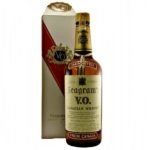 The importance of VO to Seagram
The importance of VO to SeagramLet’s start with the fact that the New York Stock Exchange symbol for Seagram was VO. That speaks volumes. Next, consider the fact that The Chairman (aka Edgar M. Bronfman) earned his stripes at the company working on VO.
It was …
The Seagram VO and VO Gold story
“Diageo sells portfolio of brands to Sazerac,” read the headline of the press release. It went on to say that among the brands acquired were Seagram’s VO and VO Gold. I found this fascinating on a number of levels. First, you might say that these brands have seen better days and why would a company like Sazerac, with a full and lush portfolio, want these brands. On the other hand, Sazerac has done amazing things with brands they acquired from Seagram (think Eagle Rare and Fireball to name only two) so, a revival of the Seagram VO franchise would not be unusual or impossible.
It was under my watch at Seagram that VO’s decline accelerated and VO Gold was created. So, among others, I contacted John Hartrey and Art Peterson (both of whom you have met before on this blog) who played important roles with those brands, back in the day. I also spoke with Drew Mayville, who worked on the creation of VO Gold and was the 4th and last Master Blender at Seagram, and is now the Master Blender at Sazerac.
{By the way, as I write this, I’ve learned that Sazerac has introduced “Mister Sam” Whiskey — a Blend of Sazerac’s American and Canadian Whiskeys and a tribute to the Seagram founder, Sam Bronfman. The blend was created by Drew Mayville.}
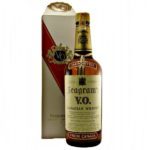 The importance of VO to Seagram
The importance of VO to SeagramLet’s start with the fact that the New York Stock Exchange symbol for Seagram was VO. That speaks volumes. Next, consider the fact that The Chairman (aka Edgar M. Bronfman) earned his stripes at the company working on VO.
It was always a great whiskey, a 6-year-old Canadian blend and the aspiration of Seagram 7 drinkers looking for more and, yes, better.
I recall, after taking over the position of U.S. marketing head, being summoned to a lunch with The Chairman in his private dining room. This was during the time that Edgar Jr was involved in Hollywood. I think, in retrospect, the purpose was to let me know that he was back in control and was in charge during this interregnum. Really? As though I didn’t know? All I recall from that lunch was that the butler asked me what I wanted to drink and I looked at him in amazement. With the exception of a special occasion, drinking at lunch was not for me. When I told him so, his look was beyond amazement as he said, “The Chairman generally has a VO before lunch… I’d suggest you do the same.”
Some believe that the term VO stood for “Very Own” and, according to the Master of Malt website, “It is said the blend was created after a post-prandial conversation (during or relating to the period after dinner or lunch) amongst the Seagram family; the letters “VO” might well stand for “very own”, as in, their very own blend…”
Art Peterson told me the following story about the family’s commitment to VO:
“When Edgar Senior and Charles (Bronfman) were running the Canadian operation, they learned that due to some production or maturation difficulties, the blenders were unable to match the character of the current VO production to the standard. So, Charles and Edgar made the decision to stop shipping the brand until they solved the problem. That meant that there were shortages in the marketplace, but they were determined that no shipments would be made until that problem was solved.” (Despite my griping about the owners, they were all about quality and doing the right product thing, no matter what.)
Most interesting to the VO story is the packaging, notably the ribbon on the bottle. I’ve been told that it was the racing colors of a Bronfman owned horse. More about that ribbon in a moment.
But tastes changed and the brand slipped
By the early 1990s, consumer liquor preferences had leaned to clear spirits in general and vodka in particular, so whiskies (with a few exceptions) suffered volume declines. At Seagram, Seagram 7 Crown was huge and a bar staple so its losses were manageable. At the other end, Crown Royal, whose appeal was to top shelf drinkers and strong regional support, actually grew in volume. In part, this was a result of an upmarket line extension — Crown Royal Special Reserve. Seagram VO was awash in red ink and, while it held its own against the archrival Canadian Club, you didn’t want to be the brand manager who presented the sales and marketing results when there was a Bronfman in the room. As in… “our sales are way down BUT, our market share is up.”
The central question became, “What to do about VO.”
Enter the Consultants
The owners of Seagram loved to bring in consulting companies such as McKinsey or Boston Consulting Group — you know, highly paid outsiders who basically ask for your watch so they can tell you what time it is. I couldn’t help but wonder why they chose to go around the company’s employees. I often felt they thought, how smart can our people be, they chose to work for us didn’t they?
Among other things the consultant contribution to the brand was to “take the goodness away,” by eliminating what they saw as ‘unnecessary’ packaging elements. You know… what we in marketing and sales call “brand personality elements.” Among the cost saving victims was the VO ribbon.
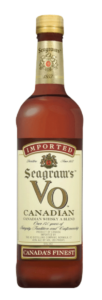 VO after the package changes
VO after the package changesThe Answer…
…came from the toilers in the company, not the consultants. In so doing, we broke what classic marketers call the rule of line extensions — don’t line extend from a weak brand. Nonsense.
There were many reasons why an upmarket VO line extension made sense, including increased margin, additional VO facings in stores, a new face in the brand’s franchise and lineup, and more. And, the success of Crown Royal Special Reserve, gave us the impetus to try that tactic on VO. What did we have to lose?
So, VO Gold was born and, with the thumbing of our noses at the consultants, we put all the goodness in packaging back into VO Gold. Including the ribbon.
But the strength of the brand came from the blenders and the marketers. Here’s how Art Peterson described what happened with the product formulation:
“Drew Mayville was part of the team and in on the creation of the brand. What happened was that VO Gold was just an idea. We knew it had to be some kind of a premium VO, but true to VO characters. We started by discussing, ‘What could we do to improve VO?’ Well, one idea, of course, is you can use older whiskeys. We decided that we would focus on eight-year-old whiskeys. And then, ‘What can we do to VO to make it different but still recognizably VO?’ We decided to go with a whiskey that would be brighter. Also, some of the characteristics in VO that we liked were the fruity characteristics, and that came from having certain yeasts that we used in our rye whiskeys in the VO blend.”
The proof of the blenders’ success came in a letter to Art from Charles Bronfman:
“I have tasted VO Gold and it’s just fabulous!!! Best damn VO I have ever tasted, and as you know, I have tasted an awful lot of VO over the years. Nice going, my friend.”
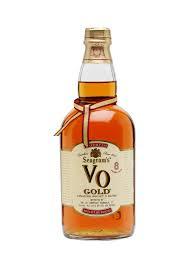 VO Gold
VO GoldWhat I especially enjoyed about Seagram was the team spirit and, in this case, how marketing worked hand in hand with the blenders and production to bring this brand to life.
Led by John Hartrey, the marketing folks came up with a totally unique idea; never done before but used by others afterward. They ran a program that centered on “meet the blender.”
What they did was communicate, through advertising and point of sale, a series of dinners in five different markets. It was a contest whereby “you and 20 of your friends” could win a dinner with Art Peterson, followed by an expert tasting with him. It was a huge success and VO Gold was on its way.
About that ribbon
John reminded me of a great story about the VO ribbon. It was removed because it required special equipment and was expensive to produce. Little did the geniuses at the consulting firm (or many of us) know that it played a role in the Viet Nam war. According to John:
“When we removed the ribbon, we got a letter from a Vietnam Vet asking why the ribbon was removed. He told us that during the war, the VO ribbon was referred to as a “short timers’ ribbon”. The idea was that when someone had a short time left on their tour (probably 30 days), he put the ribbon on his uniform so that everyone knew to protect him and get him home.”
The story was corroborated here.
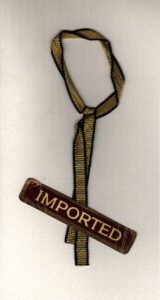 The Ribbon
The Ribbon# # #
Seagram’s VO and VO Gold now have a second shot at success. The best part is that one of the blenders who worked on the original products, Drew Mayville, is the current Master Blender for the new owners (Sazerac) of the brand.
Drew used a great expression when we spoke that really resonated with me, “A lot of companies want to meet consumer expectations. At Sazerac, we strive to delight the consumer.”
I can’t wait for it to come on the market.
Thank you John, Art and Drew for taking the time to talk with me about this.
The post The Seagram VO and VO Gold story first appeared on Booze Business: A Blog Dedicated to the Business of Spirits and Wine.
February 18, 2019
Why is it called a “cocktail?”
Ever wonder why it’s called a cocktail? I have, and I set out to learn the answer. So, I checked with Gary (Gaz) Regan, my friend and business associate and, a fountainhead of information about all sorts of booze business matters. He has written 18 books on the business including, 101 best new Cocktails, The Bartender’s Gin Compendium, and The Joy of Mixology.
It turns out that in the new revised and updated edition of The Joy of Mixology, Gaz addresses this question at the outset of this amazing book, which is full of anecdotes, stories, and cocktail recipes. With his permission here are some excerpts on “How Did a Cocktail Come to be called a Cocktail?
On May 13, 1806, the Balance and Columbian Repository of Hudson, New York, answered a reader’s query as to the nature of a cocktail: “Cocktail is a stimulating liquor, composed of spirits of any kind, sugar, water, and bitters—it is vulgarly called a bittered sling.” The cocktail had been born, it had been defined, and yet it couldn’t have been very well known by the general populace, or the newspaper wouldn’t have considered it a fit topic for elucidation.
Where does the word cocktail come from? There are many answers to that question, and none is really satisfactory. One particular favorite story of mine, though, comes from The Booze Reader: A Soggy Saga of a Man in His Cups, by George Bishop: “The word itself stems from the English cock-tail which, in the middle 1800s, referred to a woman of easy virtue who was considered desirable but impure. The word was imported by expatriate Englishmen and applied derogatorily to the newly acquired American habit of bastardizing good British Gin with foreign matter, including ice. The disappearance of the hyphen coincided with the general acceptance of the word and its re-exportation back to England in its present meaning.” Of course, this can’t be true since the word was applied to a drink before the middle 1800s, but it’s entertaining nonetheless, and the definition of “desirable but impure” fits cocktails to a tee.
A delightful story, published in 1936 in the Bartender, a British publication, details how English sailors of “many years ago” were served mixed drinks in a Mexican tavern. The drinks were stirred with “the fine, slender and smooth root of a plant which owing to its shape was called Cola de Gallo, which in English means ‘Cock’s tail.’” The story goes on to say that the sailors made the name popular in England, and from there the word made its way to America.
Another Mexican tale about the etymology of cocktail—again, dated “many years ago”—concerns Xoc-tl (transliterated as Xochitl and Coctel in different accounts), the daughter of a Mexican king, who served drinks to visiting American officers. The Americans honored her by calling the drinks cocktails—the closest they could come to pronouncing her name. And one more south-of-the-border explanation for the word can be found in Made in America, by Bill Bryson, who explains that in the Krio language, spoken in Sierra Leone, a scorpion is called a kaktel. Could it be that the sting in the cocktail is related to the sting in the scorpion’s tail? It’s doubtful at best.
One of the most popular tales told about the first drinks known as cocktails concerns a tavern keeper by the name of Betsy Flanagan, who in 1779 served French soldiers drinks garnished with feathers she had plucked from a neighbor’s roosters. The soldiers toasted her by shouting, “Vive le cocktail!” William Grimes, however, points out in his book Straight Up or On the Rocks: The Story of the American Cocktail that Flanagan was a fictional character who appeared in The Spy, by James Fenimore Cooper. He also notes that the book “relied on oral testimony of Revolutionary War veterans,” so although it’s possible that the tale has some merit, it’s a very unsatisfactory explanation.
A fairly plausible narrative on this subject can be found in Famous New Orleans Drinks & How to Mix ’em, by Stanley Clisby Arthur, first published in 1937. Arthur tells the story of Antoine Amedie Peychaud, a French refugee from San Domingo who settled in New Orleans in 1793. Peychaud was an apothecary who opened his own business, where, among other things, he made his own bitters, Peychaud’s, a concoction still available today. He created a stomach remedy by mixing his bitters with brandy in an eggcup—a vessel known to him in his native tongue as a coquetier. Presumably not all Peychaud’s customers spoke French, and it’s quite possible that the word, pronounced coh-KET-yay, could have been corrupted into cocktail. However, according to the Sazerac Company, the present-day producers of Peychaud’s bitters, the apothecary didn’t open until 1838, so there’s yet another explanation that doesn’t work.
Another theory has it that in England, horses of mixed blood had their tails docked to signify their lack of breeding, and were known as “cocktailed” horses, but since I first wrote that, the term has been clarified. David Wondrich, cocktail historian extraordinaire, has concluded that the word’s origins did indeed involve horses and their tails, but with a difference: “cocktail,” he found, was a bit of ginger or cayenne pepper that crooked horse dealers would put into tired old horses’ bums to make them cock their tails up and act a little more lively than usual.
 Gary (gaz) Regan
Gary (gaz) Regan* * *
So, there you have it… five possible explanations of the origin of the word cocktail.
I don’t know about you but I’m going with the last one, but I much prefer “down the hatch” than “bottoms up.”
Why is it called a “cocktail?”
Ever wonder why it’s called a cocktail? I have, and I set out to learn the answer. So, I checked with Gary (Gaz) Regan, my friend and business associate and, a fountainhead of information about all sorts of booze business matters. He has written 18 books on the business including, 101 best new Cocktails, The Bartender’s Gin Compendium, and The Joy of Mixology.
It turns out that in the new revised and updated edition of The Joy of Mixology, Gaz addresses this question at the outset of this amazing book, which is full of anecdotes, stories, and cocktail recipes. With his permission here are some excerpts on “How Did a Cocktail Come to be called a Cocktail?
On May 13, 1806, the Balance and Columbian Repository of Hudson, New York, answered a reader’s query as to the nature of a cocktail: “Cocktail is a stimulating liquor, composed of spirits of any kind, sugar, water, and bitters—it is vulgarly called a bittered sling.” The cocktail had been born, it had been defined, and yet it couldn’t have been very well known by the general populace, or the newspaper wouldn’t have considered it a fit topic for elucidation.
Where does the word cocktail come from? There are many answers to that question, and none is really satisfactory. One particular favorite story of mine, though, comes from The Booze Reader: A Soggy Saga of a Man in His Cups, by George Bishop: “The word itself stems from the English cock-tail which, in the middle 1800s, referred to a woman of easy virtue who was considered desirable but impure. The word was imported by expatriate Englishmen and applied derogatorily to the newly acquired American habit of bastardizing good British Gin with foreign matter, including ice. The disappearance of the hyphen coincided with the general acceptance of the word and its re-exportation back to England in its present meaning.” Of course, this can’t be true since the word was applied to a drink before the middle 1800s, but it’s entertaining nonetheless, and the definition of “desirable but impure” fits cocktails to a tee.
A delightful story, published in 1936 in the Bartender, a British publication, details how English sailors of “many years ago” were served mixed drinks in a Mexican tavern. The drinks were stirred with “the fine, slender and smooth root of a plant which owing to its shape was called Cola de Gallo, which in English means ‘Cock’s tail.’” The story goes on to say that the sailors made the name popular in England, and from there the word made its way to America.
Another Mexican tale about the etymology of cocktail—again, dated “many years ago”—concerns Xoc-tl (transliterated as Xochitl and Coctel in different accounts), the daughter of a Mexican king, who served drinks to visiting American officers. The Americans honored her by calling the drinks cocktails—the closest they could come to pronouncing her name. And one more south-of-the-border explanation for the word can be found in Made in America, by Bill Bryson, who explains that in the Krio language, spoken in Sierra Leone, a scorpion is called a kaktel. Could it be that the sting in the cocktail is related to the sting in the scorpion’s tail? It’s doubtful at best.
One of the most popular tales told about the first drinks known as cocktails concerns a tavern keeper by the name of Betsy Flanagan, who in 1779 served French soldiers drinks garnished with feathers she had plucked from a neighbor’s roosters. The soldiers toasted her by shouting, “Vive le cocktail!” William Grimes, however, points out in his book Straight Up or On the Rocks: The Story of the American Cocktail that Flanagan was a fictional character who appeared in The Spy, by James Fenimore Cooper. He also notes that the book “relied on oral testimony of Revolutionary War veterans,” so although it’s possible that the tale has some merit, it’s a very unsatisfactory explanation.
A fairly plausible narrative on this subject can be found in Famous New Orleans Drinks & How to Mix ’em, by Stanley Clisby Arthur, first published in 1937. Arthur tells the story of Antoine Amedie Peychaud, a French refugee from San Domingo who settled in New Orleans in 1793. Peychaud was an apothecary who opened his own business, where, among other things, he made his own bitters, Peychaud’s, a concoction still available today. He created a stomach remedy by mixing his bitters with brandy in an eggcup—a vessel known to him in his native tongue as a coquetier. Presumably not all Peychaud’s customers spoke French, and it’s quite possible that the word, pronounced coh-KET-yay, could have been corrupted into cocktail. However, according to the Sazerac Company, the present-day producers of Peychaud’s bitters, the apothecary didn’t open until 1838, so there’s yet another explanation that doesn’t work.
Another theory has it that in England, horses of mixed blood had their tails docked to signify their lack of breeding, and were known as “cocktailed” horses, but since I first wrote that, the term has been clarified. David Wondrich, cocktail historian extraordinaire, has concluded that the word’s origins did indeed involve horses and their tails, but with a difference: “cocktail,” he found, was a bit of ginger or cayenne pepper that crooked horse dealers would put into tired old horses’ bums to make them cock their tails up and act a little more lively than usual.
 Gary (gaz) Regan
Gary (gaz) Regan* * *
So, there you have it… five possible explanations of the origin of the word cocktail.
I don’t know about you but I’m going with the last one, but I much prefer “down the hatch” than “bottoms up.”
The post Why is it called a “cocktail?” first appeared on Booze Business: A Blog Dedicated to the Business of Spirits and Wine.
December 13, 2018
The Future of the Booze Business
It was announced recently that Republic National Distributing Co (RNDC), and Liberation Distribution (LibDib) have formed a strategic alliance and will be working together.
I consider this a huge development for the wine and spirits industries and I was anxious to learn what it means for the future. I very much admire Tom Cole of RNDC and Cheryl Murphy Durzy of LibDib and was thrilled to have an exclusive interview with both of them. The three of us talked about how this development came about and what it means for the distribution of both large and small brands.
RNDC is the second largest distributor in the US, operating in 22 markets with a long history dating back to before Prohibition. It is an organization built on the strong foundations of three family-owned companies. What I’ve always admired about RNDC is their values, marketplace effectiveness, and people you enjoy working with.
LibDib is the first technology company to offer a 3-tier compliant model that provides an option for the growing number of makers (suppliers/manufacturers) that are entering the market. Launched in June, 2016 and they describe themselves as: “A wholesale distributor of alcoholic beverages enabled through a web and mobile platform.” (An earlier article I wrote about LibDib is here.)
As reported by Wine and Spirits Daily, LibDib suppliers will be able to use RNDC’s logistics and expand throughout their footprint, while RNDC will have access to LibDib’s technology and data. To me, it is also a union of the traditional and new routes to market.
So, what does this mean?
 Tom Cole, CEO RNDC
Tom Cole, CEO RNDC
According to Tom Cole:
“When I first learned about LibDib, I was fascinated by the commitment to the 3-tier system…I believe in and am a passionate protector of that system, so the LibDib approach offering effective online ordering, satisfies the need for small makers that are having difficulty getting to market…”
 Cheryl Durzy, CEO LibDib
Cheryl Durzy, CEO LibDibCheryl added:
“We use the term evolve — How are we going to evolve the 3-tier system to meet the needs of the modern consumer and what they are looking for in spirits and wine.”
In effect, LibDib will have the opportunity to expand from its current operations in New York and California and ultimately operate in RNDC’s 22 markets. They’ll be able to tap into RNDC’s advanced logistics to deliver craft products to buyers in all available markets.
In turn, RNDC will have access to LibDib’s technology and data collection, thereby enabling them to further expand their value and services. In effect, they will be offering their large supplier organizations access to the rapidly changing market place by offering insights and actions into the new and evolving consumer.
What I think is particularly appealing, is that RNDC, which doesn’t currently operate in NY and CA, will have access to those markets in a new and unique way.
The problem being solved
Let’s start with craft spirits products and small brands.
IWSR has produced the Craft Sprits Report 2018, which looks at the current and future growth of craft spirits in the US.
They report that in 2017, the craft spirit volume share of all spirits sales was 3.3% which is 7.5 million 9-liter cases and up 25% from the previous year. They forecast that by 2022, craft spirit brands will account for close to 20% of all spirits and more than double its share at 7.9%.
In terms of value, craft brands accounted for 4.6% share of all spirits and, by 2022, they forecast it to be 10.4%.
What really caught my eye was this statement: “To put the current size of craft spirits into perspective, the 7.5m case total is roughly equal to the entire U.S. brandy category in 2017.”
So, what’s the problem?
The route to market available to large brands is not generally available to small brands, particularly start up ventures or fledgling brands from small craft or other distilleries. The result is a hodgepodge of distribution solutions. Some large distributors will take on these brands but more as an exception than a rule. Come on… you would do the same if you ran a spirits and wine distributorship. It’s a volume driven business that largely depends on mass and mainstream brands. As a distributor put it to me once, “hey, you want my sales folks to stop focusing on a proven winner to sell your maybe-it-will-make-it brand?”
As a result, small spirits companies often rely on wine and beer distributors. Both wine and spirits companies will aim for importers with a distribution network or companies like MHW LTD or Park Street Imports (both with distributor licenses in a few key markets). All in the hope for an effective route to market and in compliance with the 3-tier mandatory system.
The large company conundrum
Developing new products/brands and getting them to market is difficult for the large makers as well.
Imagine you’re a major player in a leading spirits and wine company. You look around and, while your mass brands are doing okay, the craft/small batch brands are eating away at your volume. The cocktail focus has won the attention of bartenders and consumers alike and your mainstream brand is in danger of becoming yesterday’s newspaper.
Your options are to stick your head in the sand and ignore the changing market place and consumer behavior. That won’t work because your kid needs braces so your bonus might be in jeopardy. So, you figure out that you need to enter the fray and either start acquiring some of those fledgling brands or build your own through your innovations group.
Now you have another problem. The distribution and business models are based on large volume and you don’t want your people, or your distributor’s people, focusing on your new “baby” while ignoring the brands that need the attention. You can either launch a small brand-focused business unit or find a better, more cost-effective solution.
As many of you know, at Seagram I ran new products at one point and this venture of combining the clout of RNDC and the LibDib model would be just what I needed to succeed. In short, this strategic alliance between a top distributor and a company focused on small brands would have made my mouth water by allowing me to get into the small producer game, while still keeping my eye on the (big brand) ball.
How this came about
My hats off to Tom Cole who has the vision and smarts to see where the industry is going and to move his business in an advantageous direction. And to Cheryl, whose tenacity and foresight will reap benefits to her innovation.
I’ve known Tom a long time and he’s a visionary, always attuned to the changing marketplace, and willing to explore new opportunities and directions. It’s no surprise, therefore, that when he learned about LibDib, he looked into it.
Cheryl and her family ran a small winery in northern California and learned firsthand what a nightmare it is for a small company to get to the shelves of restaurants, bars, and stores. She created LibDib as a solution. In a relatively short period of time the company has attracted large numbers of makers and retail (bar and store) accounts in New York and Los Angeles. LibDib has become a viable and growing go to market resource.
After a number of exploratory phone calls, they met at the WSWA and learned that they had a great deal in common — the yearning to find a solution for new brands, a shared vision of the future, the support for the 3-tier system, entrepreneurial focus, and approaches to business management. Back and forth conversations and due diligence followed and a year later RNDC invested in LibDib and they are now partners.
What’s next?
There is much work to be done to maximize the potential of this venture and 2019 will involve some beta testing in NY and LA. Beyond that they will be exploring efforts on a state by state basis. There’s a lot to learn and this is a work-in-progress, undoubtedly with a slow and steady pace, making sure all the kinks are worked out. As Tom put it, “We will do things thoughtfully and correctly and increase our likelihood success.”
So far as I’m concerned, this development changes everything.
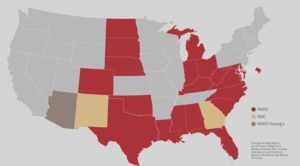 RNDC markets
RNDC markets

